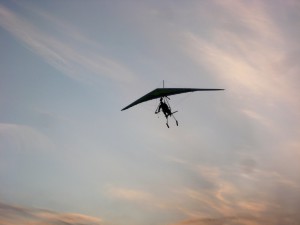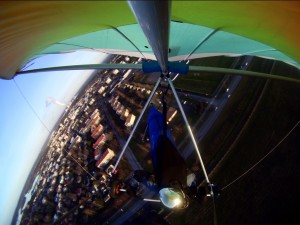Riippuliitimen suorituskyky määräytyy hyvin pitkälti sen mukaan, että kyseessä on lentolaite, jonka lentoonlähdöt ja laskeutumiset on suunniteltu tapahtuvan jaloilta. Näin ollen liitimen lentoonlähtö- ja sakkausnopeus tulee pitää pienenä, 20-30 km/h tietämillä. Tämä asettaa tiettyjä vaatimuksia lentolaitteen suunnittelulle ja rakenteelle, jonka vuoksi liitimien huippunopeudet jäävät parhaimmillaankin vain n. 100 km/h paikkeille. Koska moottoroitu riippuliidin on käytännössä sama, jolla lennetään myös ilman moottoria, ovat suorituskykyarvot niinikään käytännössä vastaavanlaiset.
Moottoroitu riippuliidin saavuttaa moottorillaan käytännössä parhaimmillaan kolmen kilometrin lentokorkeuden optimaalisissa olosuhteissa. Mitä korkeammalle mennään, sitä ohuemmaksi ilma muuttuu ja sitä vähemmän on moottorilla happea käytettävissä. Liitimen lentäjä ei vielä kolmen kilometrin korkeudessa merenpinnasta tarvitse lisähappea, mutta moottoriin hapen määrän väheneminen vaikuttaa suuresti. Hapen määrän väheneminen tekee palamistapahtumasta epäoptimaalisen, käytännössä moottori käy rikkaammalla seoksella kuin normaalisti. Moottoroiduissa riippuliitimissä käytetyissä moottoreissa polttoaineseosta ei yleensä voi lennon aikana säätää. Seoksen muuttuminen rikkaaksi pienentää moottorin tehontuottoa. Vastaavasti myös potkuri toimii ohuemmassa ilmassa heikommin. Nämä tekijät rajoittavat lentokorkeutta.

Riippuliitimen sekä moottoroidun liitimen liitosuhde vaihtelee koulutusliitimien 8:1:stä aina kilpaliitimien 15:1-18:1 -lukemiin. Liitosuhde 8:1 tarkoittaa sitä, että jokaista alaspäin liidettyä kilometriä kohden liidin liitää eteenpäin kahdeksan. Mikäli moottori sammutetaan kilometrin korkeudessa, pääsee optimaalisissa olosuhteissa parhaan liitoluvun tuottaman lentonopeuden valitsemalla kahdeksan kilometrin päähän.
Liitimet testataan ja sertifioidaan kestämään pääsääntöisesti +6 G kuormitus. Kevyestä rakenteesta huolimatta liitimet ja valjaat kestävät kuormitusta erityisen hyvin. Reilut varmuuskertoimet tekevät lentämisestä huoletonta ja turvallista.
Lentoaika moottoroiduilla liitimillä vaihtelee tunnista neljään-viiteen tuntiin. Laitteissa oleva moottori kuluttaa n. 2.5 litraa tunnissa kaksitahtiöljyllä terästettyä 98E:tä matkalentotehoilla. Liitimien tankkeihin mahtuu polttoainetta 5-10 litraa. Neljän tunnin aikana liidin voi 50-80 km/h matkanopeudellaan kulkea verrattain pitkiäkin matkoja.
English
 The performance of a hang-glider is defined by it’s ability to be foot-launched. Keeping that in mind, the gliders take-off and stall speed should be kept as low as possible, like 20-30 km/h. This sets limitations to the gliders structure and aerodynamics. The low-speed handling characteristics limit the top speeds. So the best performance glider can reach only slightly over 100 km/h airspeeds. As in powered hang-gliding the same speed is used as in free-flight, the same performance numbers apply.
The performance of a hang-glider is defined by it’s ability to be foot-launched. Keeping that in mind, the gliders take-off and stall speed should be kept as low as possible, like 20-30 km/h. This sets limitations to the gliders structure and aerodynamics. The low-speed handling characteristics limit the top speeds. So the best performance glider can reach only slightly over 100 km/h airspeeds. As in powered hang-gliding the same speed is used as in free-flight, the same performance numbers apply.
The powered hang-glider is able to reach the altitude of 3 kilometres (approx. 9000 ft). The higher the glider climbs, the less there are oxygen available. At the altitude of three kilometers from the sea level the pilot does not require additional oxygen, but the engine’s performance is affected. The decreased amount of oxygen makes the combustion inefficient and the engine runs with too rich mixture which decreases its performance. The efficiency of the propeller is also affected in thinner air. In the majority of powered hang-gliders, the fuel-air ratio is not adjustable in-flight, which limits the available power at high altitudes and so the maximum altitude is also limited.

While unpowered, the glide ratio of the hang-glider varies from 8:1 to 15-18:1. The beginner-level gliders and skyfloaters have the glide ratio of 8:1 while the higher performance competition gliders and rigid-wing gliders can reach up to 18:1 glide ratios. The glide ratio of 8:1 means that the glider flies forward 8 kilometers per every descended kilometer. So if the engine is shut down at altitude of one kilometer, the glider is able to fly eight kilometers in optimal conditions when flown at the optimal airspeed for the best glide ratio.
While hang gliders are not built for aerobatics, they are tested and certified to withstand 6 G’s of positive load. Despite of their very lightweight construction, the equipment is able to withstand loads very well. Large safety cofactors make flying safe.
 The range and flight time of powered gliders vary from one hour to slightly over four hours. The engine consumes approximately 2,5 liters of mixture of 98E gasoline and two-stroke fuel per hour. The fuel tanks are able to hold 5-10 liters of fuel each depending on the tank. The maximum amount of fuel and tanks is limited by the weight limitations of the glider. During four hours, the glider is able to cover rather long distances with its 50-80 km/h cruise speed.
The range and flight time of powered gliders vary from one hour to slightly over four hours. The engine consumes approximately 2,5 liters of mixture of 98E gasoline and two-stroke fuel per hour. The fuel tanks are able to hold 5-10 liters of fuel each depending on the tank. The maximum amount of fuel and tanks is limited by the weight limitations of the glider. During four hours, the glider is able to cover rather long distances with its 50-80 km/h cruise speed.